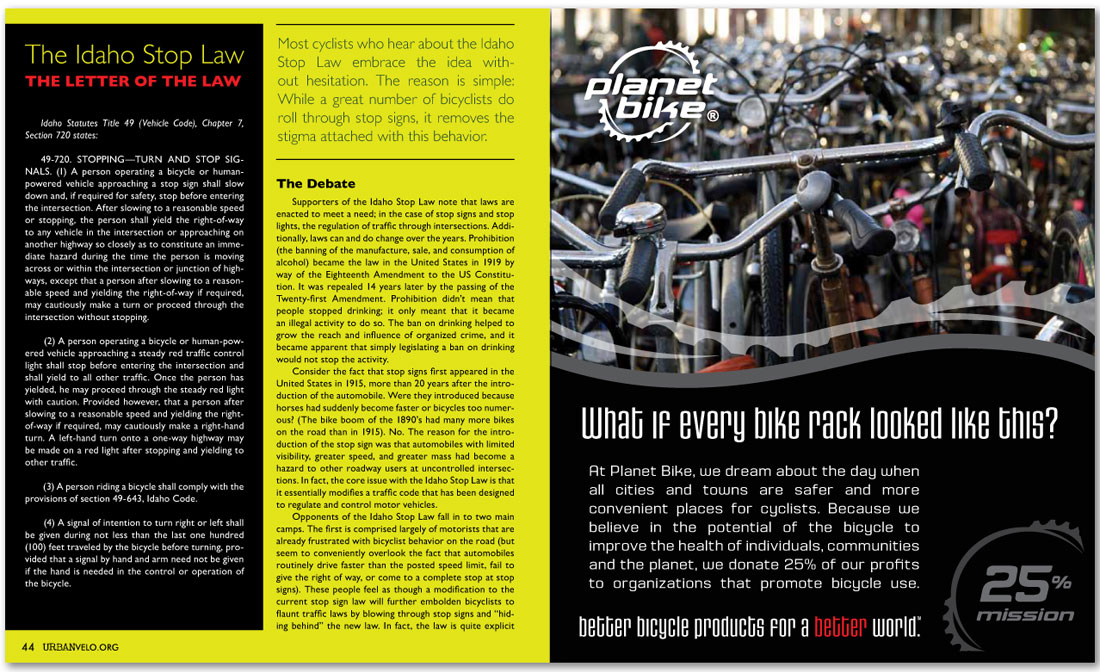


The Debate
Supporters of the Idaho Stop Law note that laws are enacted to meet a need; in the case of stop signs and stop lights, the regulation of traffic through intersections. Additionally, laws can and do change over the years. Prohibition (the banning of the manufacture, sale, and consumption of alcohol) became the law in the United States in 1919 by way of the Eighteenth Amendment to the US Constitution. It was repealed 14 years later by the passing of the Twenty-first Amendment. Prohibition didn’t mean that people stopped drinking; it only meant that it became an illegal activity to do so. The ban on drinking helped to grow the reach and influence of organized crime, and it became apparent that simply legislating a ban on drinking would not stop the activity.
Consider the fact that stop signs first appeared in the United States in 1915, more than 20 years after the introduction of the automobile. Were they introduced because horses had suddenly become faster or bicycles too numerous? (The bike boom of the 1890’s had many more bikes on the road than in 1915). No. The reason for the introduction of the stop sign was that automobiles with limited visibility, greater speed, and greater mass had become a hazard to other roadway users at uncontrolled intersections. In fact, the core issue with the Idaho Stop Law is that it essentially modifies a traffic code that has been designed to regulate and control motor vehicles.
Opponents of the Idaho Stop Law fall in to two main camps. The first is comprised largely of motorists that are already frustrated with bicyclist behavior on the road (but seem to conveniently overlook the fact that automobiles routinely drive faster than the posted speed limit, fail to give the right of way, or come to a complete stop at stop signs). These people feel as though a modification to the current stop sign law will further embolden bicyclists to flaunt traffic laws by blowing through stop signs and “hiding behind” the new law. In fact, the law is quite explicit
Planet Bike
The Idaho Stop Law
THE LETTER OF THE LAW
Idaho Statutes Title 49 (Vehicle Code), Chapter 7,
Section 720 states:
49-720. STOPPING—TURN AND STOP SIGNALS.
(1) A person operating a bicycle or humanpowered
vehicle approaching a stop sign shall slow
down and, if required for safety, stop before entering
the intersection. After slowing to a reasonable speed
or stopping, the person shall yield the right-of-way
to any vehicle in the intersection or approaching on
another highway so closely as to constitute an immediate
hazard during the time the person is moving
across or within the intersection or junction of highways,
except that a person after slowing to a reasonable
speed and yielding the right-of-way if required,
may cautiously make a turn or proceed through the
intersection without stopping.
(2) A person operating a bicycle or human-powered
vehicle approaching a steady red traffic control
light shall stop before entering the intersection and
shall yield to all other traffic. Once the person has
yielded, he may proceed through the steady red light
with caution. Provided however, that a person after
slowing to a reasonable speed and yielding the rightof-
way if required, may cautiously make a right-hand
turn. A left-hand turn onto a one-way highway may
be made on a red light after stopping and yielding to
other traffic.
(3) A person riding a bicycle shall comply with the
provisions of section 49-643, Idaho Code.
(4) A signal of intention to turn right or left shall
be given during not less than the last one hundred
(100) feet traveled by the bicycle before turning, provided
that a signal by hand and arm need not be given
if the hand is needed in the control or operation of
the bicycle.